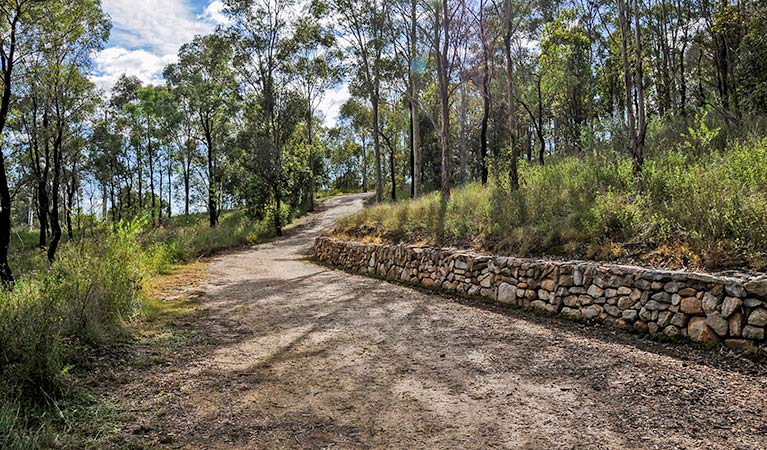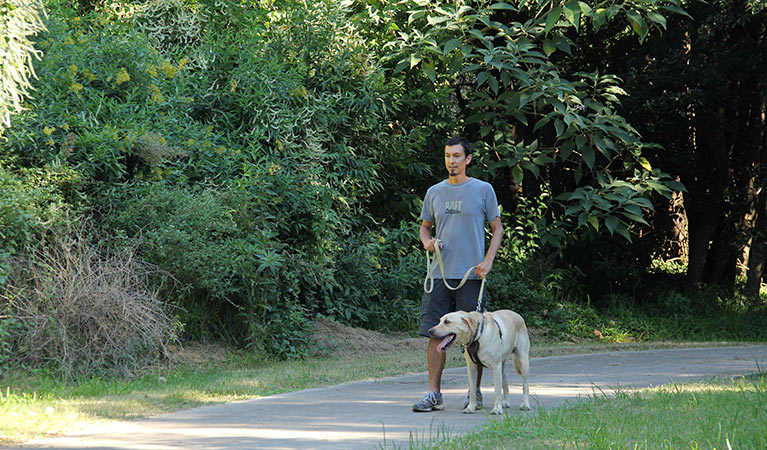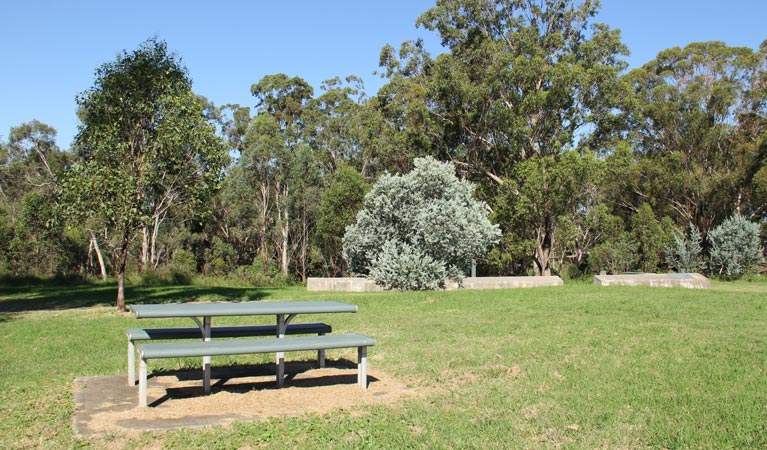Leacock Regional Park
Overview
Located in Casula, southwest Sydney, Leacock Regional Park is a great spot of dog walking, jogging, cycling and picnicking.
Read more about Leacock Regional Park
Leacock Regional Park provides a welcome patch of open green space at Casula in Sydney's southwest. From the ridge line you can enjoy views over the bushland of Holsworthy.
Visit the park to see some of the state’s rarest trees or enjoy a picnic at the park’s picnic area. Explore the park’s walking tracks along the banks of the Georges River, they link the park with other facilities such as the Casula Powerhouse Arts Centre.
It’s a great place to exercise – go for a jog or a bike ride through the park, and it’s a dog-friendly park, so you can bring Rover and Spot along for a walk.
Local alerts
For the latest updates on fires, closures and other alerts in this area, see https://uat.nswparks.cloud/visit-a-park/parks/leacock-regional-park/local-alerts
Map

Map legend

Contact
- in the Sydney and surrounds region
Leacock Regional Park is always open but may have to close at times due to poor weather or fire danger
-
-
Scheyville office
02 4580 2750
Contact hours: Monday to Friday, 8.30am to 4.30pm. Closed public holidays. - 71 Memorial Drive, Scheyville 2756
-
Email: npws.cumberland@environment.nsw.gov.au
-
Scheyville office
Visitor info
All the practical information you need to know about Leacock Regional Park.
Maps and downloads
Nearby towns
Campbelltown (18 km)
For nature lovers, the Macarthur region has plenty of natural attractions. Explore nature reserves and wildlife trails or see spectacular native flora and fauna at the Australian Botanic Garden Mount Annan, the largest botanic garden in Australia.
Parramatta (20 km)
Parramatta offers a fascinating insight into early colonial life in Australia. Don't miss a visit to Old Government House, now one of 11 Australian Convict Sites on the UNESCO World Heritage list.
Sydney City Centre (40 km)
No trip to Sydney is complete without spending some time in the city’s beautiful parks. Whether it’s in central areas like Hyde Park or the Royal Botanic Gardens or further out in Centennial Parklands, there’s plenty of green space to go out and enjoy.
Learn more
Leacock Regional Park is a special place. Here are just some of the reasons why:
Significant flora

Leacock Regional Park is part of the Cumberland Plain woodland, an endangered ecological community that houses the critically endangered Cumberland Plain land snail. The park is also one of the few places in NSW where you can see the rare tree species, blue box eucalyptus, as well as some of the oldest native and endemic trees in metropolitan Sydney. The Weaving Garden Environment Group is currently carrying out bush regeneration within the park.
Great for relaxing

Swap tall buildings and busy roads for this pretty patch of nature. Leacock Regional Park offers the opportunity to escape and clear your mind in a delightful natural setting, right on your doorstep. It’s ideal for cycling and jogging along the edges of Glenfield Creek and the Georges River. If you’re looking for a western Sydney park to walk your dog, then look no further than Leacock Regional Park. Dogs are welcome here, as long as they’re on-leash and the 1.6km Bellbird walking track will give you both a good workout – particularly if you make it a return trip.
- Bellbird walking track You’ll find the Bellbird walking track in Leacock Regional Park, southwestern Sydney. It’s a lovely stroll to and from Casula station, with birdwatching opportunities, too.
- Leacock picnic area The picnic area at Leacock Regional Park, just off the Hume Highway near Casula, is a great rest stop on a long drive or for a picnic with your dog in toe.
Plants and animals protected in this park
Animals
-

Common brushtail possum (Trichosurus vulpecula)
One of the most widespread of Australian tree-dwelling marsupials, the common brushtail possum is found across most of NSW in woodlands, rainforests and urban areas. With strong claws, a prehensile tail and opposable digits, these native Australian animals are well-adapted for life amongst the trees.
-
Cumberland Plain land snail (Meridolum corneovirens)
The endangered Cumberland Plain land snail is only found on the Cumberland Plain, west of Sydney. During drought it digs deep into the soil to escape harsh conditions. Its brown shell is thin and fragile.
Environments in this park
Education resources (1)
What we're doing
Leacock Regional Park has management strategies in place to protect and conserve the values of this park. View the detailed park and fire management documents. Here is just some of the work we’re doing to conserve these values:
Understanding landscapes and geology
A varied and diverse landscape is found in the park, from bushland in the north, to the historic rural landscape of Glenfield Farm in the central and southern portions. This landscape provides interest, diversity and a relatively natural setting for people visiting and living in the area. To maintain the landscape value of this park, NPWS recognises the need to undertake work to minimise the impact of soil erosion, weeds and stormwater run-off.
Preserving biodiversity
Leacock Regional Park provides an important biodiversity link and wildlife movement corridor to adjoining areas including Glen Regent Reserve to the south, and remnant vegetation along the Georges River to the east. It also links with the extensive bushland of Holsworthy Military Reserve. The two dams, particularly the one at the southern end of the Park, as well as the escarpment, provide important habitat for native animals. NPWS will deliver recovery plans and implement best practice guidelines to assist in recovery of endangered and vulnerable plant and animal species in this park.
Managing weeds, pest animals and other threats
Pests and weeds have an impact on the biodiversity values of Leacock Regional Park. Reduction of pest species, as well as risk assessment for new and emerging weeds, is an important part of the work NPWS to protect the biodiversity values of this park.
Historic heritage in our parks and reserves
Leacock Regional Park has an historic connection with Glenfield Farm, arguably the most intact representation of rural farm complexes from the Macquarie period that survives in NSW. NPWS will continue to protect and manage cultural heritage features of Leacock Regional Park to ensure this value is preserved for the future.
Conserving our Aboriginal culture
Aboriginal culture and connection to nature are inseparable and need to be managed in an integrated manner across the landscape of Leacock Regional Park. NPWS will continue to consult Darug descendant groups and other interested Aboriginal community organisations as to the ongoing management of this park, in particular the mangement of Aboriginal sites, places and natural values.
Managing fire
NSW is one of the most bushfire prone areas in the world as a result of our climate, weather systems, vegetation and the rugged terrain. NPWS is committed to maintaining natural and cultural heritage values and minimising the likelihood and impact of bushfires via a strategic program of fire research, fire planning, hazard reduction, highly trained rapid response firefighting crews and community alerts.

